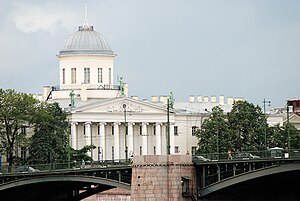|
Pushkin House The Pushkin House (Russian: Пушкинский дом, romanized: Pushkinsky Dom), formally the Institute of Russian Literature (Институ́т ру́сской литерату́ры), is a research institute in St. Petersburg. It is part of a network of institutions affiliated with the Russian Academy of Sciences. HistoryEstablishmentThe Russian Literature Institute began its life in December 1905 as the main centre for Alexander Pushkin studies in Imperial Russia. A commission in charge of erecting a Pushkin monument in St. Petersburg, led by Sergei Oldenburg and Aleksey Shakhmatov, suggested a permanent institution be set up to preserve original Pushkin manuscripts:[1]
The idea won support from all sides and was welcomed by Grand Duke Constantine Constantinovich. It was understood that the Pushkin House would be housed in a purpose-built Neoclassical edifice, or Odeon, but the idea failed to materialize owing to a lack of funds.[1] In 1907 Vladimir Kokovtsov, Minister of Finance, came up with the proposal to acquire a huge collection of Pushkin manuscripts and memorabilia amassed in Paris by Alexander Onegin from 1879 onwards. The negotiations dragged on until Onegin's death in 1925, but the bulk of his collection eventually ended up in Russia.[1] Soviet era The Pushkin House was originally a non-governmental organization specializing in Pushkin studies, which have been recognized by Russian authorities as a separate branch of scholarly inquiry. The Russian Revolution led to the shutdown of all non-governmental institutions, but the Pushkin House was spared and put under the umbrella of the Russian Academy of Sciences (in 1918). Such "honorary" directors as Anatoly Lunacharsky, Lev Kamenev and Maksim Gorky ensured its safe passage through the hardships of the Revolution.[1] In 1927 Pushkin House moved from the crammed rooms in the Academy of Sciences building to the magnificent neo-Palladian Customs House, built after Giovanni Francesco Lucchini's designs in 1829–1832 and situated just around the Strelka.[2] It was to the original Kunstkamera rooms that Alexander Blok referred in his last poem To Pushkin House, celebrating Pushkin's heritage as a gleam of hope during the chaos and confusion of the post-revolutionary years:[3]
The Pushkin House remained open during the Siege of Leningrad, although most of the staff and manuscripts were evacuated to other cities. Following the war the institute continued, employing such scholars as Boris Eikhenbaum and Dmitry Likhachov. StructureThe collections of the Pushkin House, partly housed in a modern block hidden behind the Neoclassical facade, include numerous manuscripts from the 13th century onward, portraits and personal documents of leading Russian authors, as well as a galaxy of rare music recordings. The institution has a complex structure and is subdivided into several departments: 
The Pushkin memorial houses in Mikhailovskoye, Trigorskoye, Tsarskoe Selo, and on the Moyka River are also affiliated with the Pushkin House.[4] Directors
References
External links |